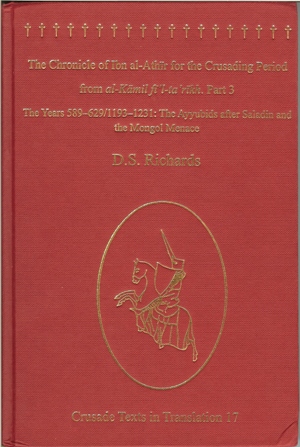
De Re Militari | Book Reviews
D.S. Richards
The Chronicle of Ibn al-Athir for The Crusading Period from al-Kamil fi'l-Ta'rikh, part 3
The Years 589-629/1193-1231: The Ayyubids after Saladin and the Mongol Menace
Crusade Texts in Translation 17. Aldershot, Hampshire: Ashgate, 2008. 344pp.

This is the third installment of D.S. Richard’s beautiful translation of Ibn al-Athir’s al-Kamil fi’l-Ta’rikh or Complete History. Indeed, although Richards has only translated the later portions which are relevant to the Crusades, Ibn al-Athir’s masterpiece actually consists of twelve volumes. One can only hope that Richards or another scholar of equal caliber will continue the process.
The third volume chronicles of events in the Islamic world after Saladin’s death, aptly demonstrating the fractious nature of Ayyubid state. The volume proceeds year by year, thus giving readers a solid chronology of events not only in Egypt and the Levant but also throughout North Africa, albeit in much smaller doses. Ibn al-Athir’s chronicle also ventures outside of the Islamic world and discusses activities in the Caucasus, such as the rise of a powerful Georgian state, as well as Byzantine history. The reader thus benefits from the full experience of the world of Outremer, exposing the complexities of the era and location that are often lost in secondary narratives. Of equal importance is the considerable attention that Ibn al-Athir gives to the rise of the Khwarazmian Sultanate in Central Asia. The rise of the Khwarazm Shahs came at the expense of the Seljuk Sultanate in Iran and against any hope for the re-emergence of the Abbasid Caliphate or the Afghanistan based sultanates of Ghazna and Ghur. One can quickly grasp why the eastern Islamic world paid little attention to the events of the Levant.
As the Khwarazmian Sultanate expanded it also encountered a new force from the steppes of Eurasia: the Mongols. Although, at this time, the Mongols are not directly tied to the Crusades, the Mongols would play a pivotal role in the by the mid-thirteenth century. Ibn al-Athir’s work has long been of use to those studying the Mongols and working with Arabic sources. Richards’ translation catches all of the subtleties and horrors of the original account. Indeed, one easily understands how the Islamic world viewed the Mongols not so much as any human enemy, but rather as the wrath of God or as a natural calamity. Those teaching courses related to the medieval Middle East will find a wealth of anecdotes to relate to their classes to make this point.
Although at times Richards uses a few rather antiquated spellings, his translation is accurate and highly readable, often making up for Ibn al-Athir’s sometimes stylistically simplistic writing. The book is adequately footnoted with explanatory material for Arabic terminology and locations that would have been obvious for Ibn al-Athir’s audience, but less readily so for modern Western readers. It is a welcome and much needed addition to the studies of the Crusades, the medieval Middle East, and of course, the Mongols. In all of these fields, too often there has been a dearth of translated materials accessible to students and scholars who work outside of the field or unable to read Arabic. This volume should find a home in every university library, and hopefully the shelves of scholars and students.
